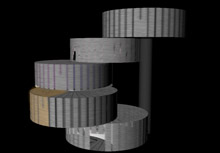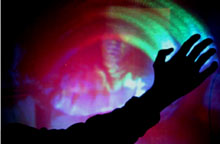Cortical
Fusion

introduction
Overview
Symbol Zone
Texture Room
Rainbow Room
Malleable Space
Sonic Zones
Visualization Zone
Walkthrough

Texture Room

Touch Me
Here visitors explore associations with tactile sensations. Electrovibration screen material lines the walls, inviting the visitor to engage in an unusually intimate exploration of the space, caressing their surroundings in search of pairings. At times a color or word appears embedded in the wall screens, requiring the visitor to feel for the texture they personally associate with the visual. At other times there is a sound, and the visitor seeks those textures which align to the aural experience.

Feeling Around in the Dark
As a visitor entering this room, you would immediately be struck by its apparent darkness. This lack of light is meant to act as a temporary deprivation of the normally overbearing sense of sight, placing the focus on tactile presence in space. You would be almost forced to feel along the walls in order to navigate about the room. Momentary dots of light along the wall would attract your attention and feel. Each of these would have their own corresponding texture. At other times, sounds would emanate from different locations accompanied by any number of possible tactile feelings. The exploration of this environment would leave you with a very vivid example of cross sensory pairings as led by the often neglected sense of touch.
Tactile Exploration
Here are some examples of sights and sounds you might hear. Try to imagine feeling a texture which corresponded with these images and noises. What would each sound feel like? Smooth? Sharp? Rough? Rubbery? What would each image feel like? Should a red blob feel rough or slimy? Think back to the Kiki-Booba experiment if you need a place to start.
Experience 1: Darkness, Play sound
Alternative content
Experience 2: Green Streaks Run Accross the Walls

Experience 3: As Green Streaks Fade Away, Play Sound
Alternative content
Experience 4: Static Lightning fills the Room

Experience 5: Lightning fades away, Play Sound
Alternative content
Experience 6: Assorted Blotches of Color

Conclusion
What did you find out? Any surprises or tough calls?
Sometimes it can be quite difficult to associate an image or sound with a sense of feeling, especially when it is not something we are used to interacting with on a physical level, such as a bolt of lightning or abstract colors and shapes. Certain types of Synaesthetes actually experience tactile feeling from sounds, colors, movement, shapes, numbers, or other experiences. Anyone who has ever had chills from listening to a particularly beautiful piece of music can understand this phenomenon.
Technology
Tactile exploration is facilitated by electrovibration technology, which basically enables a touch-screen to mimic or recreate almost any textured surface. As the name suggests, it does this through the generation of extremely small electrically induced magnetic fields. These microscopic changes in charge, cause the surface to literally push and pull the viewer's moving fingers, which in turn creates a simulation of friction. Since different objects and materials have characteristic types of friction, this technique tricks our fingers into thinking we are touching these objects when in reality we are not.
References
http://www.teslatouch.com/
http://www.teslatouch.com/technology.html
www.walkermobile.com/March_2010_ID_Haptic_Force_Feedback.pdf
Visitor tracking
Data collection in the Texture Zone requires technology to track individual visitors' movement through the space, and synchronize that with the visuals or audio present at the time. For example, if visitors see an image of the word "happy" throughout the room, the system must synchronize the texture at which they spend the most time (perhaps a smooth, roundish texture,) in order to save that association. At a later time, if a bird chirping audio clip is played, the system must similarly associate a visitor's "choice" of texture with that piece of audio. This allows the Data Zone to effectively visualize synesthetic trends in the population.
The tracking technique employs an array of cameras mounted on the ceiling. Accompanying this is a software system that unwarps, aligns, and calibrates the camera images. Further computer vision algorithms, including background subtraction, segmentation and optical flow, are utilized to distinguish each individual visitor and maintain tracking, even when many visitors are present in the space.
This technology is similarly employed in the Sonic Zone and Rainbow Zone.
Sketches


